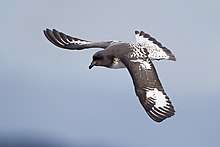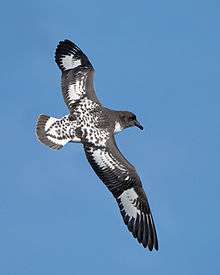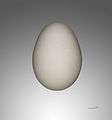Cape petrel
The Cape petrel (Daption capense), also called the Cape pigeon, pintado petrel, or Cape fulmar,[4] is a common seabird of the Southern Ocean from the family Procellariidae. It is the only member of the genus Daption, and is allied to the fulmarine petrels, and the giant petrels. They are extremely common seabirds with an estimated population of around 2 million.
| Cape petrel | |
|---|---|
 | |
| D. capense australe south east of Tasmania | |
| Scientific classification | |
| Kingdom: | Animalia |
| Phylum: | Chordata |
| Class: | Aves |
| Order: | Procellariiformes |
| Family: | Procellariidae |
| Genus: | Daption Stephens, 1826 |
| Species: | D. capense |
| Binomial name | |
| Daption capense | |
| Subspecies | |
| |
| Synonyms | |
|
Procellaria capensis Linnaeus, 1758 | |

Taxonomy and etymology
The Cape petrel is the only known member of the genus Daption and is in turn a member of the family Procellariidae and order Procellariiformes. There appears to be a subgroup within the family consisting of the giant petrels, the members of Fulmarus, the Antarctic petrel, and the snow petrel.[5]
All Procellariiformes share certain identifying features. First, they have nasal passages that attach to the upper bill called naricorns. The bills of Procellariiformes are also unique in that they are split into between seven and nine horny plates. They produce a stomach oil made up of wax esters and triglycerides that is stored in the proventriculus. This can be sprayed out of their mouths as a defence against predators and as an energy rich food source for chicks and for the adults during their long flights.[6] Finally, they also have a salt gland that is situated above the nasal passage and helps desalinate their bodies, due to the high amount of ocean water that they imbibe. It excretes a high saline solution from their nose.[7]
Subspecies
The Cape petrel has two subspecies
- D. capense capense breeds on circumpolar subantarctic islands.[8]
- D. capense australe breeds on New Zealands subantarctic islands.[8]
Etymology
Daption is derived from Ancient Greek for "little devourer", and the Cape name is because of where the type specimen was collected. Finally, pintado is Spanish for "painted" for its plumage. One of their other names, Cape pigeon, is from their habit of pecking at the water for food.[3] The word petrel is derived from St. Peter and the story of his walking on water. This is in reference to the petrel's habit of appearing to run on the water to take off.[9]
Description
The Cape petrel is a unique looking petrel. It has a black head and neck, and a white belly, breast, and its underwing is white with a black border. Its back, and upperwings are black and white speckled, as is its tail which also has a band of black. When fully grown, their wings span 86 cm (34 in) and they are 39 cm (15 in) long.[3][10]
Behaviour
Diet
The Cape petrels' diet is 80% crustaceans, as well as fish and squid. Krill is their favourite crustacean, which they obtain by surface seizing as well as diving under water and filtering them out.[3][10] They are also well known for following ships and eating edible waste and carcasses thrown overboard. They are aggressive while feeding and will spit their stomach oil at competitors, even their own species.[3]
Breeding
They are colonial birds, and nest on cliffs or level ground within a kilometre of the ocean.[3] They tend to have smaller colonies than other petrels.[10] Their nests are formed with pebbles and are placed under overhanging rock for protection,[3][10] or in a crevice.[10] In November they lay a single clear white egg, which is incubated for 45 days by both sexes. The egg usually measures 53 by 38 millimetres (2.1 in × 1.5 in).[11] Like most other fulmars, they will defend their nest by spitting stomach oil. Skuas in particular will prey on Cape petrel eggs and chicks. Upon hatching, the chick is brooded for ten days until it can thermoregulate, after which both parents assist in the feeding. The chicks fledge after 45 more days, around March.[3]
Range and habitat
During breeding season, Cape petrels feed around Antarctica's shelf and during the winter they range further north, as far as Angola and the Galapagos Islands. They breed on many islands of Antarctica and the subantarctic islands, some going as far as the Auckland Islands, the Chatham Islands, Campbell Island. Their main breeding grounds were on the Antarctic Peninsula, South Georgia, the Balleny Islands, the Kerguelen Islands, as well as islands in the Scotia Sea.[3]
Conservation
The Cape petrel has an occurrence range of 146,000,000 km2 (56,370,915 sq mi) and a 2009 estimate places their population of adult birds at 2 million. Consequently, the IUCN rates them as least concern.[12]
Gallery
 Nesting on King George Island
Nesting on King George Island Egg
Egg In flight
In flight Illustration
Illustration
Footnotes
- BirdLife International (2012). "Daption capense". IUCN Red List of Threatened Species. 2012. Retrieved 26 November 2013.CS1 maint: ref=harv (link)
- Brands, Sheila (15 Aug 2008a)
- ZipCode Zoo (16 Jul 2009)
- Fraser, Ian; Gray, Jeannie (2013). Australian Bird Names: A Complete Guide. CSIRO. p. 46. ISBN 9780643104709.
- Tree of Life (27 Jun 2008)
- Double, M. C. (2003)
- Ehrlich, Paul R. (1988)
- Clements, James (2007)
- Gotch, A. T. (1995)
- Harrison, C. & Greensmith, A. (1993)
- Hauber, Mark E. (1 August 2014). The Book of Eggs: A Life-Size Guide to the Eggs of Six Hundred of the World's Bird Species. Chicago: University of Chicago Press. p. 41. ISBN 978-0-226-05781-1.
- BirdLife International (2012)
References
- Brands, Sheila (15 Aug 2008). "Systema Naturae 2000 / Classification – Genus Daption-". Project: The Taxonomicon. Retrieved 22 Feb 2009.
- Brands, Sheila (15 Aug 2008a). "Systema Naturae 2000 / Classification – Daption capense". Project: The Taxonomicon. Archived from the original on 2007-11-05. Retrieved 22 Feb 2009.
- Brooke, M. (2004). "Procellariidae". Albatrosses And Petrels Across The World. Oxford, UK: Oxford University Press. ISBN 0-19-850125-0.
- Clements, James (2007). The Clements Checklist of the Birds of the World (6th ed.). Ithaca, NY: Cornell University Press. ISBN 978-0-8014-4501-9.
- Double, M. C. (2003). "Procellariiformes (Tubenosed Seabirds)". In Hutchins, Michael; Jackson, Jerome A.; Bock, Walter J.; Olendorf, Donna (eds.). Grzimek's Animal Life Encyclopedia. 8 Birds I Tinamous and Ratites to Hoatzins. Joseph E. Trumpey, Chief Scientific Illustrator (2nd ed.). Farmington Hills, MI: Gale Group. pp. 107–111. ISBN 0-7876-5784-0.
- Ehrlich, Paul R.; Dobkin, David, S.; Wheye, Darryl (1988). The Birders Handbook (First ed.). New York, NY: Simon & Schuster. pp. 29–31. ISBN 0-671-65989-8.
- Gotch, A. F. (1995) [1979]. "Albatrosses, Fulmars, Shearwaters, and Petrels". Latin Names Explained A Guide to the Scientific Classifications of Reptiles, Birds & Mammals. New York, NY: Facts on File. pp. 191–192. ISBN 0-8160-3377-3.
- Harrison, C.; Greensmith, A. (1993). Bunting, E. (ed.). Birds of the World. New York, NY: Dorling Kindersley. p. 50. ISBN 1-56458-295-7.
- Tree of Life (27 Jun 2008). "Procellariidae. Shearwaters, Petrels". Tree of Life Web Project. Retrieved 18 Mar 2009.
- Trewby, Mary (2002). Antarctica: an encyclopedia from Abbot Ice Shelf to zooplankton. Auckland, New Zealand: Firefly Books Ltd. p. 46. ISBN 1-55297-590-8.
- ZipCode Zoo (3 Jul 2009). "Daption capense australe (Snare Cape Pigeon)". BayScience Foundation. Archived from the original on 2012-06-09. Retrieved 20 Jul 2009.
External links
| Wikimedia Commons has media related to Daption capense. |
